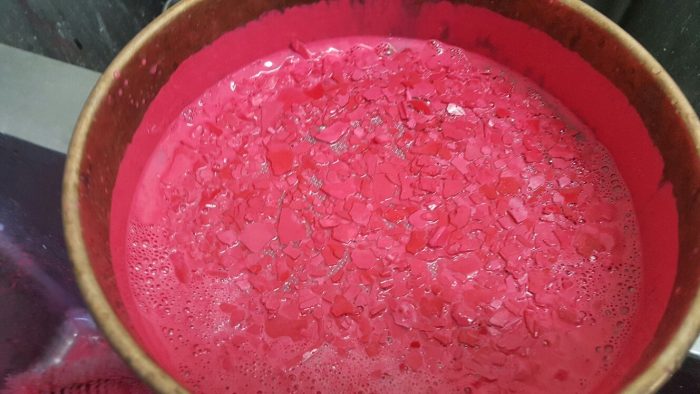The front pages of some major, rural papers have been covered with agrochemical product recalls caused by contamination. There can be many reasons for a recall of which cross contamination is but one.

Figure 1. The contents of one 10 L drum of a poor quality, imported, imidacloprid seed dressing poured through a laboratory sieve demonstrating the “egg shell” effect.
For instance, we often hear of products recalled because of stability problems. Product instability causes the user many headaches but the most common are filter/nozzle blockages and poor performance. Poor product stability damages: sales, reputations, staff morale and adds costs. The cause is not always straightforward. One variable usually underestimated is the conditions under which the product has been stored and transported. At Eureka! we are passionate about the stability and well-being of chemicals used on-farm, in the home or in gardens. We can help sort out stability problems.
With three major failure mechanisms, high concentration imidacloprid products are well known for their fickle stability. This product can settle on the bottom, turn to the consistency of toothpaste or be filled with what looks like broken egg shells (see Figure 1). Each of these mechanisms is triggered by an entirely different series of events, most of which are only understood by a handful of people in the industry. Being so complicated its little wonder that many generic manufacturers have trouble with it!
Whilst studying imidacloprid stability we came across something unexpected to do with storage conditions. We put a temperature logger onto a pallet of 10 L containers and trucked it from Melbourne to Perth, unloaded into a warehouse for a week before reloading it onto another truck returning it to Melbourne. The trip took 21 days and the results were alarming!
On the trip to Perth, the temperature peaked at 46°C with a minimum of 13°C. The temperature fluctuated wildly between day and night with the maximum daily difference being 24°C. On the return to Melbourne, the temperature hit a very disturbing 58°C before plummeting a massive 33°C overnight. When we add up the total time spent in temperatures above 35°C for the trip it equaled nearly 3 days.
The market expects agchem products to have a shelf-life of two years. It might surprise you that the standard tests used to test such products assumes they will be stored at a constant 23°C, which is nothing like the conditions in Australian sheds. Higher temperatures degrade pesticides far more rapidly (see Table 1). The 3 days this shipment spent exposed to temperatures above 35°C probably took three weeks off its shelf life. It might not sound like much but it is coupled with a maximum temperature exposure of 58°C which is higher than any standard temperature test the industry use on agchems.

Table 1. Effect of increasing temperate on the rate of agricultural chemical degradation.
For many products a temperature that cycles up and down causes more damage than a constant, high temperature. Imidacloprid again makes a very good example of this.
Imidacloprid is sold as a suspension concentrate (SC) formulation. It has very fine imidacloprid crystals suspended in water that has been thickened. Its stability is closely related to the size of these crystals. If they get bigger they will overcome the thickener’s resistance and settle to the bottom. Imidacloprid is at the very upper limit of solubility suitable for an SC. A problem with most generic imidacloprid products is that when the temperature in storage rises on a hot day more imidacloprid will dissolve into the water. The smallest crystals dissolve first. When the product cools overnight less imidacloprid can be dissolved into the water and so new crystals form but these are far larger than the original crystals. The same cycle is repeated over and over generating more and more big crystals. These large crystals settle to the bottom breaking the product’s stability and increasing the risk of filters and nozzles blockages.
The take home message
Elevated temperatures and temperature cycling are the natural enemies of chemical stability. They occur during transport and in most warehouses and in storage sheds on: farms, golf courses, in pest control operator sheds and in houses. This contributes to product failures and recalls.
If you are having problems with the stability of any product call us, we can help.
If you would like to talk about improving the stability of products, please contact the friendly Eureka! AgResearch team on (03) 9369 4177 or if calling from NZ +61 39369 4177, and ask for Anthony Flynn.
Written By: Anthony Flynn
© 2017 Eureka! AgResearch Pty Ltd

